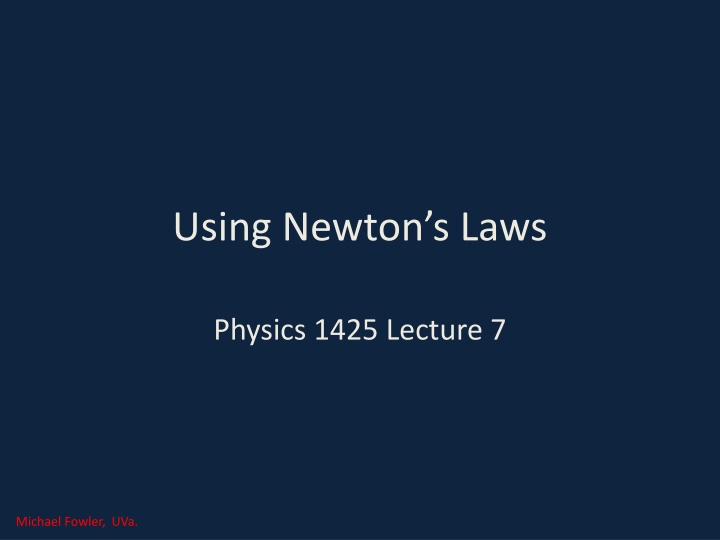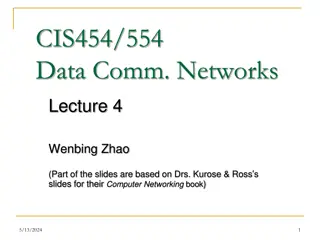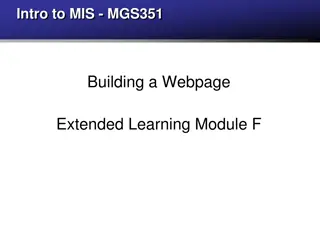
Weight, Normal Force, and Free Body Diagrams in Physics
Explore concepts of weight, normal force, and free body diagrams in physics, including the force of gravity, inertial mass, and the interaction between springiness and forces. Learn how these principles govern the behavior of objects in different scenarios.
Download Presentation

Please find below an Image/Link to download the presentation.
The content on the website is provided AS IS for your information and personal use only. It may not be sold, licensed, or shared on other websites without obtaining consent from the author. If you encounter any issues during the download, it is possible that the publisher has removed the file from their server.
You are allowed to download the files provided on this website for personal or commercial use, subject to the condition that they are used lawfully. All files are the property of their respective owners.
The content on the website is provided AS IS for your information and personal use only. It may not be sold, licensed, or shared on other websites without obtaining consent from the author.
E N D
Presentation Transcript
Using Newtons Laws Physics 1425 Lecture 7 Michael Fowler, UVa.
Todays Topics Weight: the force of gravity The Normal Force: a surface pushes back Free Body Diagrams: finding the total force on a body
Weight: the Force of Gravity Newton introduced the idea of a gravitational force to explain Galileo s natural downward acceleration . Previously, force was only used to describe direct physical contact forces, the idea of a gravitational force seemed weird kind of irrational and magical.
Weight and Inertial Mass All falling objects have the same acceleration (when air resistance is eliminated), so applying F ma = = mg the gravitational force on an object its weight must be directly proportional to its inertial mass. (It isn t obvious why this should be true!) If an object is taken to the Moon, its inertial mass doesn t change it takes the same energy to accelerate a car. But its weight does change.
The Normal Force Right now, the force of gravity is pulling us all downwards but we re not moving! = F mg What about ? Remember is the total force on a body. F If the floor disappears, I will accelerate downwards!
The Normal Force Conclusion: the floor is providing the force balancing that of gravity: it s called the normal force. Question: how can something as inert and immoveable as the floor provide a force? Clue: how does a spring balance provide a force to measure weight?
Normal Force and Springiness When the tomatoes are put on the scale, it moves down, compressing a spring until the spring s force balances gravity. The floor is elastic too! Where you stand, it sags a little, and pushes back like a very stiff spring.
Clicker Question I stand on roller skates facing a wall. I reach out and push against the wall, I accelerate backwards. What force caused my acceleration? A. My arm and back muscles B. My pushing against the wall C. The normal force from the wall D. Friction between the skates and the floor
Clicker Question I stand on roller skates facing a wall. I reach out and push against the wall, I accelerate backwards. What force caused my acceleration? A. My arm and back muscles B. My pushing against the wall C. The normal force from the wall D. Friction between the skates and the floor A body can only be accelerated by an outside force and friction only helps if I actively push against the floor, as in skating.
Clicker Question What is the normal force from the elevator floor on a person weighing mg, if the elevator is accelerating upwards at 0.1g? A. 1.1mg B. mg C. 0.9mg D. None of the above
Clicker Question What is the normal force from the elevator floor on a person weighing mg, if the elevator is accelerating upwards at 0.1g? = + = F mg N ma A. 1.1mg B. mg C. 0.9mg D. None of the above Link to movie! mg N
Tension! In Newton s original statement of his Third Law, he features a horse pulling a rope attached to a stone. The tension in the string means that if the stone is subject to a certain force from the horse s efforts, the horse feels an equal and opposite force from the tug of the string. The string is pulling inwards at both ends.
Tension Puzzle A one kg mass hangs from the string, the other end is looped over a hook. Suppose the looped end of the string is taken from the hook, put over the pulley, and a one kg mass is hung from that end too. What will the spring scale read now? A. About the same B. About double
Tension Puzzle Answered We did the experiment, this is what we saw: The tension in the string is the weight of one kg, 9.8N. In the first case, the string was pulling the hook with 9.8N force, and the hook was pulling right back!
Free Body Diagrams To apply Newton s Laws to find how a body moves, we must focus on that body alone and add all the (vector) forces acting on it. The diagram showing all the forces on one body (or even part of a body) is called a free body diagram we ve freed the body from the rest of the system, representing everything else just by the forces on this body. = The net (total) force then goes into . F ma
Clicker Question The strings shown are all at 120 to each other. For the vertical string, T = Mg. What is T in one of the sloping strings? A. Mg/2 B. Mg C. Mg/ 3
Clicker Question Answer The strings shown are all at 120 to each other. For the vertical string, T = Mg. What is T in one of the sloping strings? A. Mg/2 B. Mg C. Mg/ 3 The knot where the strings meet isn t moving so the three forces acting there add to zero. They form an equilateral triangle, so all forces have the same magnitude (you can also balance vertical components.)
Further Explanation The knot where the strings meet isn t moving so the three forces acting there add to zero. If you add together three vectors, the sum is the vector going from the tail of the first vector to the head of the last one. If they add to zero, the head of the last must be at the tail of the first! So they form a triangle And the sides of this triangle must be in the direction of the original forces: drawing the angles right determines the relative lengths of the sides. You can also balance vertical components: the slanting strings are at 30 to the horizontal, so the sloping string tension force has a vertical component equal to Tsin30 = T/2.






















